#oxford handbook
Text

Oxford Handbooks are not only brilliant for quick revision before clinical internships,but they can also boost up your cry-baby mood from all day spent in hospital with pearls like this ❣️
(omg he was kissed REPEATEDLY!!)
#Shoul I re-consider my chosen specialty ?#Ophtalmology is so romantic?!#better mood after reading this#medical university#oxford handbook#clinical medicine#medical stuff#medical humor#medblr#medblr community#medical training#oxford books#med school#hospital#clinical pearls#studyspread#tmedic#studyblr#i wanted to cheer you up#boost mood#❤️#ophtalmology#clinicalstudy
11 notes
·
View notes
Text
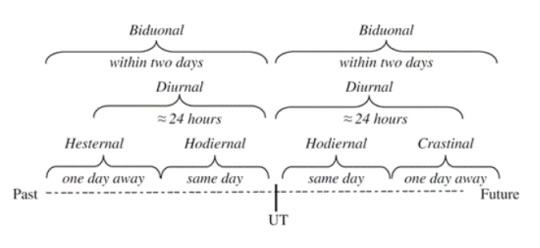
Remoteness distinctions in tense systems (Figure 18.1).
Botne, Robert. 2012. Remoteness Distinctions. In Robert I. Binnick (ed.), The Oxford Handbook of Tense and Aspect, 536-562. Oxford University Press. https://doi.org/10.1093/oxfordhb/9780195381979.013.0018.
#tense#remoteness#oxford university press#oxford handbook of tense and aspect#robert botne#robbert i. binnick#2012
46 notes
·
View notes
Text
Soooo due to events I'm apparently about to write my bachelor's in philosophy about art philosophy
#More specifically AI and art#And my supervisor said I should try to find resources on art philosophy#He suggested these:#'routledge companion to aesthetics'#'Oxford handbook of aesthetics'#'the transfiguration of the commonplace' and 'the artworld' by Arthur Danto#But said also to search for academic articles and papers#If anyone has any suggestions pls hit me up#(I think I'm mainly looking at you moss. Lol)#Nagnerd#Art philosophy?#'bout to become educated 😎 no longer an art philosophy n00b
7 notes
·
View notes
Text
the center for hellenic studies is emerging as a strong contender for worst ebook format
#not sure whether it knocks out oxford handbooks online though. just for the sheer factor of being open access#mine
17 notes
·
View notes
Text
so great that my college library only has one copy of a poetry anthology that otherwise costs ONE HUNDRED AND SEVENTY FIVE EURO
#on what planet should the oxford handbook of modern irish poetry cost that much#anyway i will be searching for this elsewhere. fucking hell
2 notes
·
View notes
Text
don't look at me i just discovered the oxford handbook of light in archaeology and as someone obsessed with being a light-bringer and light motif and imagery.......... i NEED TO READ THIS
#BUT I STILL HAVE TO FINISH FINALS LMAO#.chatter#the oxford handbook of egyptology my fucking beloved tho
10 notes
·
View notes
Text
so after three weeks, i have finished sorting all the books, chapters, and articles on my computer into a usable database
final file count: 1,442
#669 of which are oxford handbook chapters from that one download spree i went on in first year#it was A Lot Of Chapters#the last week and a half has been just those guys#mea res
1 note
·
View note
Text
I cannot make another $100+ purchase before my first paycheck for the semester comes in
#the oxford handbook of film theory is 30% off preorder#but that's still $121#and I JUST bought new glasses#AND this whole steam deck debacle#and groceries cost SO much right now#and I haven't been paid since may#but............. I should own this book and I don't want to spend the $170 it is full price rip
1 note
·
View note
Text
New Research Article: Creating Inclusive Linguistics Communication: Crash Course Linguistics
This handbook chapter is a behind-the-scenes of how the Crash Course Linguistics video series came together. I’m really proud that this article includes contributions from the linguistics writing team, including my co-writer Gretchen McCulloch, and our fact checker Jessi Grieser, but also from members of the Complexly team, who produced the show, including Nicole Sweeney, Rachel Alatalo, Hannah Bodenhausen and Ceri Riley. As with the actual videos themselves, this was a dream team. Lingcomm that is inclusive doesn’t just happen as an accident - in this article we discuss some of the ways we set things up to make the best series we could.
This chapter is also a dream project, because it’s part of the excellent double feature: Inclusion in Linguistics and Decolonizing Linguistics, both edited by Anne Charity Hudley, Christine Mallinson, & Mary Bucholz for Oxford University Press. These books are both be available through digital open access. They include some of your new favouite classics about the state of linguistics in research, education and outreach, even if you don’t know that just yet.
Abstract
This case study vignette provides an insight into the choices made in the writing of Crash Course Linguistics (Complexly/PBS 2020). This series of sixteen 10-minute videos cover core introductory level topics for English speakers who consume online content. We discuss how the topics were selected and arranged into a series order. We also discuss the ways we actively built inclusion into the series workflow and content, including in the team that worked on the content, the language examples selected and topics covered. Throughout we discuss the challenges and benefits of working in a collaborative team that includes a media production company and linguists with a commitment to public engagement and communication linguistics to new audiences. Sharing these observations about putting Crash Course Linguistics together is part of our commitment to using public communication to advance the standard of public engagement with the field, and the field’s approach to inclusive practice.
Reference
Gawne, Lauren, Gretchen McCulloch, Nicole Sweeney, Rachel Alatalo, Hannah Bodenhausen, Ceri Riley & Jessi Grieser. 2024. Creating Inclusive Linguistics Communication: Crash Course Linguistics. In Anne H. Charity Hudley, Christine Mallinson, and Mary Bucholtz (Eds), Inclusion in Linguistics, 383-396. Oxford University Press. [Open Access]
See Also:
Open Access for the whole Inclusion in Linguistics volume
Crash Course Linguistics on YouTube
Mutual Intelligibility posts for Crash Course Linguistics
#linguistics#language#crash course#crash course linguistics#lingcomm#inclusion in linguistics#publications
133 notes
·
View notes
Text
me: fills out the form to request that the library scan a chapter from a book they have on the shelves, as is their practice and as they have done for me many times before
the library: "sorry, we don't scan from books that are available electronically."
the e-book version:

#i ended up checking out the book and taking it immediately from the library desk to the library scanners#so now i have my decently formatted pdf that i can print and mark up#this is hands down the worst ebook ive ever seen really giving the oxford handbooks a run for their money#i cannot read like that!#its HORIZONTAL#mine
16 notes
·
View notes
Text
Found something while doing reading for school which may have partially inspired the Locked Tomb series:

The story this quote is referring to comes from The Book of John Mandeville (Source: Jeffrey Jerome Cohen's "Pilgrimages, Travel Writing, and the Medieval Exotic", The Oxford Handbook of Medieval Literature in English, pg 6/20).
Obvs there is a connection with the name "John" and the story of a man devoted to a woman in a tomb, which reflects John Gaius' relationship with Alecto. There is also a connection to Harrow and her desire for Alecto as well.
I'm not really sure if there's anything else to make of this but I thought I would put it out there. Apologies if someone else has already pointed it out.
#tlt#the locked tomb#gideon the ninth#harrow the ninth#nona the ninth#alectopause#harrowhark nonagesimus#john gaius#alecto tlt
62 notes
·
View notes
Text
Some readings and resources for further exploration of medieval literature, history, and art
"The Canterbury Tales" by Geoffrey Chaucer
"Beowulf" translated by Seamus Heaney
"The Song of Roland" translated by Dorothy L. Sayers
"The Divine Comedy" by Dante Alighieri
"The Decameron" by Giovanni Boccaccio
"The Book of Margery Kempe" by Margery Kempe
"The Lais of Marie de France" translated by Glyn S. Burgess and Keith Busby
"The History of the Kings of Britain" by Geoffrey of Monmouth
"The Mabinogion" translated by Sioned Davies
"The Romance of Tristan and Iseult" translated by Joseph Bédier
In addition to these literary works, here are some resources for further exploration of medieval history and art:
"A Short History of the Middle Ages" by Barbara H. Rosenwein
"The Civilization of the Middle Ages" by Norman F. Cantor
"The Time Traveler's Guide to Medieval England" by Ian Mortimer
"The Oxford Illustrated History of Medieval Europe" edited by George Holmes
"Medieval Art" by Veronica Sekules
"A Medieval Life : Cecilia Penifader and the world of English peasants before the plague" by Judith Bennett
"The Oxford Handbook of Women and Gender in Medieval Europe" by Judith M. Bennett, Ruth Mazo Karras
The Metropolitan Museum of Art's collection of medieval art and artifacts
The British Library's collection of medieval manuscripts and documents
The Medieval Academy of America's resources and publications on medieval studies
The International Center of Medieval Art's resources and publications on medieval art
These resources should provide a good starting point for further exploration of medieval literature, history, and art.
287 notes
·
View notes
Text
A Trad Husband's Handbook: Grooming and Fashion


TradHusbands should be well groomed at all times, including biweekly haircuts and barbershop shaves. The barbershop can be a good place for bonding, especially meeting older TradHusbands who are on their 9th or 10th pregnancies and can share tips for a long and happy marriage.


Barbershops are places of community, so feel free to bring your little ones. There is never a shortage of other customers willing to hold and play with your precious babies. But as you know, only you can provide nourishment, so the barber will fully understand your need to breastfeed during your service.

When pregnant, keep your skin smooth and stretchmark free with regular moisturizing. While most grooming and exercise should be discreet and away from your husband's view, you and he may enjoy incorporating lotions and massage into your nightly routine.




When it comes to fashion, a well trained TradHusband can cultivate a capsule wardrobe that is modest, elegant, and practical. Slacks, slip-on loafers, oxford shirts, and soft knits will serve you well. An apron will keep your outfit clean in the event of company. Choose flattering silhouettes and hand tailor your clothes as needed.
Do not give in to temptation to stock your closet with "athleisure" separates! Your Head of Household's love is conditional; appearing slovenly is the fast track to your husband finding another man up to his standards.
#mpreg#pregnant man#pregnant dad#male lactation#mpreg story#mpreg kink#mpregnancy#submisive and breedable#submisive sissy#satire#gay story#tradblkdaddie#tradhusband
52 notes
·
View notes
Text
still sorting my many many pdfs and like. i know why ppl do this. but articles with title like "what happens in sophocles' philoctetes?" always crack me up
like scholars published in peer reviewed journals 🤝 high schooler abt to read an off-brand sparknotes summary
#btw if anyone ever needs/wants anything from an oxford handbook in a field related to classics hmu#i have uhhhhhh. very many chapters.#i found out i had institutional access at the end of my first year and kinda went nuts with with it#as in. abt 850 chapters on my computer sort of nuts.#mea res
1 note
·
View note
Note
hii i love your blog!! what do you think is a good book to start to read about christian mysticism?
it depends on where your interest lies—history, theology, practice. i highly recommend martin laird's into the silent land, a sunlit absence, and an ocean of light, all of which discuss contemplative practice. dorothee soelle's the silent cry: mysticism and resistance. most works by thomas merton are very accessible. julian of norwich's revelations of divine love. all of st. john of the cross' work but particularly his poetry. belden c. lane's ravished by beauty: the surprising legacy of reformed spirituality for a protestant take on christian mysticism; it is, in fact, surprising (though i would advise caution about some of lane's other work). howard thurman's deep is the hunger. the wiley-blackwell companion to christian mysticism, the oxford handbook of mystical theology, bernard mcginn's essential writings of christian mysticism—the latter being a good primer on the classic christian mystics.
63 notes
·
View notes
Text
Bisexuality, Biphobia, and Health
This is going to be a quick run-through, but no doubt I'll return to this topic in future posts. For now:
The following are the statistically significant (i.e. strong evidence) findings of Horn and Swartz, 2019, “A Comparative Analysis of Lifetime Medical Conditions and Infectious Diseases by Sexual Identity, Attraction, and Concordance among Women: Results from a National U.S. Survey”:
Bisexual women reported higher rates of poverty (26.4%) than homosexual (18.9%) or heterosexual women (15.7%)
Bisexual women reported higher rates of asthma (18%) than homosexual (16.5%) or heterosexual women (10.8%)
Bisexual women reported higher rates of hepatitis B/C and were more likely to report having had an STI in the last 12 months than homosexual or heterosexual women
Bisexual women were more likely to report having had any form of cancer than heterosexual women
The 2016 “Comparison of Health and Health Risk Factors Between Lesbian, Gay, and Bisexual Adults and Heterosexual Adults in the United States: Results From the National Health Interview Survey” found:
46.4% of bisexual women had symptoms of moderate or severe psychological distress, compared to 28.4% of homosexual women, and 21.9% of heterosexual women
11.7% of bisexual women reported heavy alcohol consumption, compared to 8.9% of homosexual women and 4.8% of heterosexual women
Bisexual women were found to be more likely to have multiple chronic health conditions than heterosexual women
The 2016 “Intragroup Variance in Lesbian, Gay, and Bisexual Tobacco Use Behaviors” study found that bisexual women are more likely to smoke than homosexual or heterosexual women.
“Sexual orientation health inequality: Evidence from Understanding Society, the UK Longitudinal Household Study”, 2017, found that bisexual respondents had worse physical functioning scores, psychological distress scores, and health and life satisfaction scores than heterosexual respondents.
The Oxford Handbook of Sexual and Gender Minority Mental Health (Bostwick and Harrison, 2020), finds bisexual women to have worse rates of depression, anxiety, and substance use. They reference Conron et al., 2010, who found bisexual women to be TEN TIMES more likely to have considered suicide in the last year than heterosexual or homosexual women, and that bisexual women were more likely to have attempted suicide than any other group studied. They also reference Kerridge et al., 2017, who found bisexual women to have the highest prevalence of PTSD of any group studied, that bisexual people have more personality disorder diagnoses than heterosexual or homosexual people, and that bisexual women have significantly higher odds of a bipolar diagnosis. The book makes a point of noting that stereotypes about bisexual people may factor into diagnostic criteria and processes.
And just for good measure, below the cut is the entire bisexual chapter of "LGBT Health: Meeting the Needs of Gender and Sexual Minorities", 2018 - full references and digital text available on request:

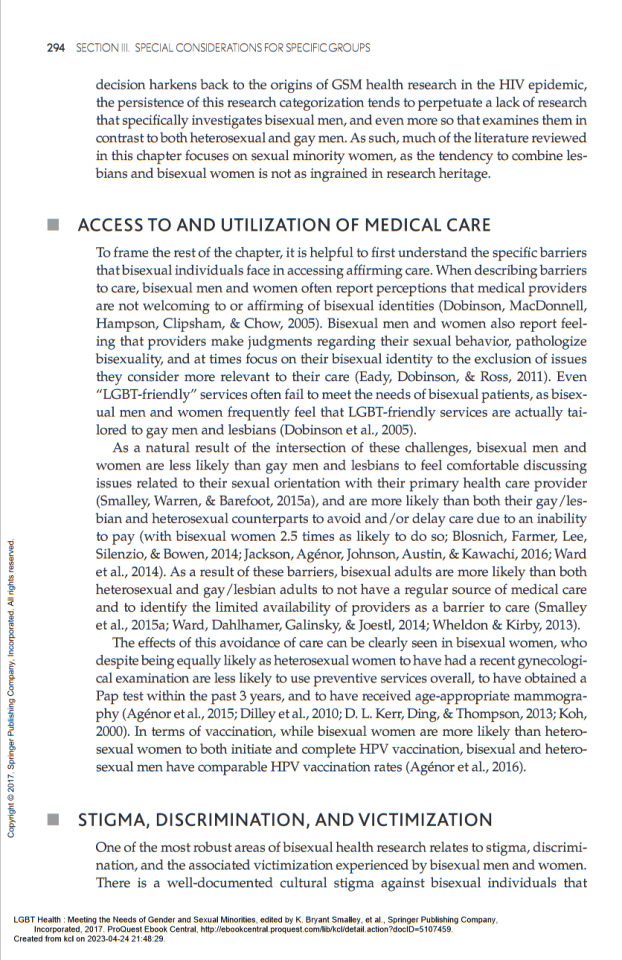
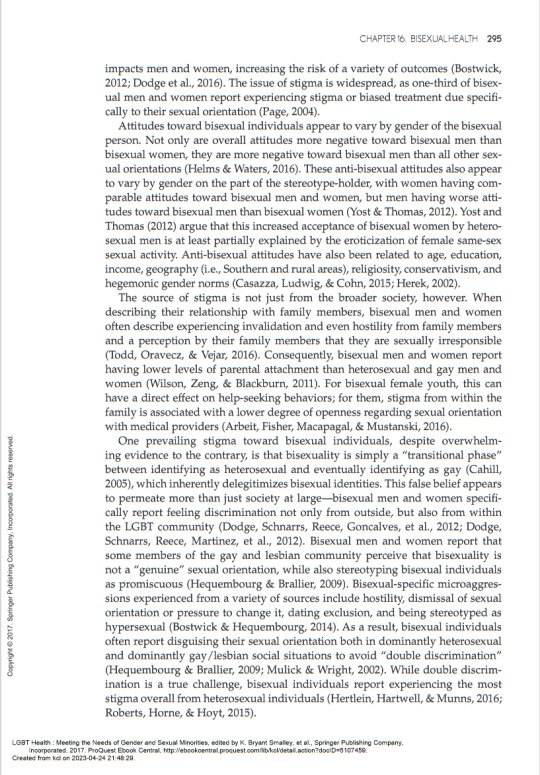

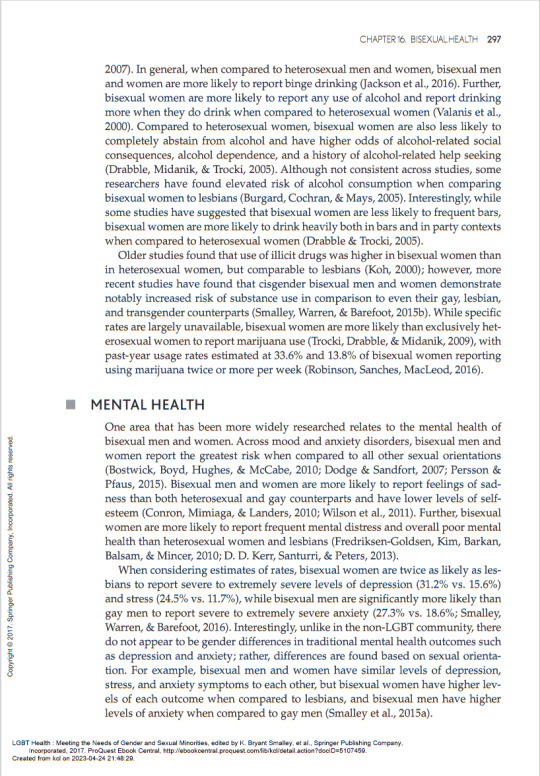

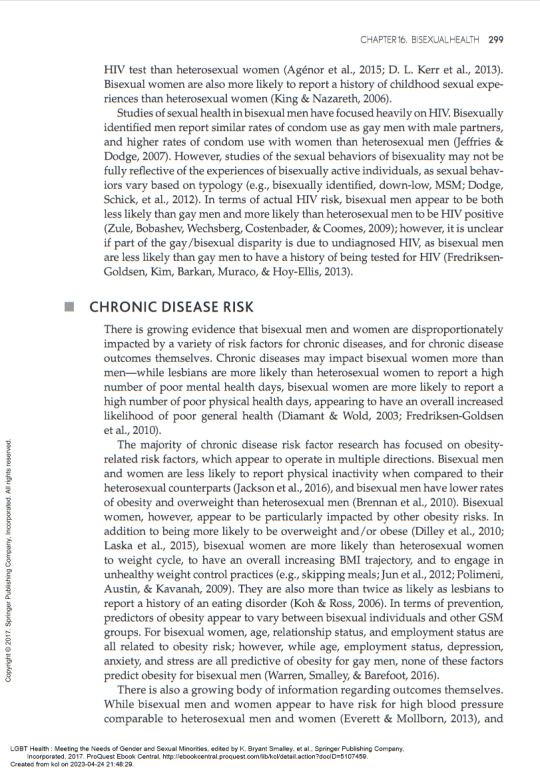
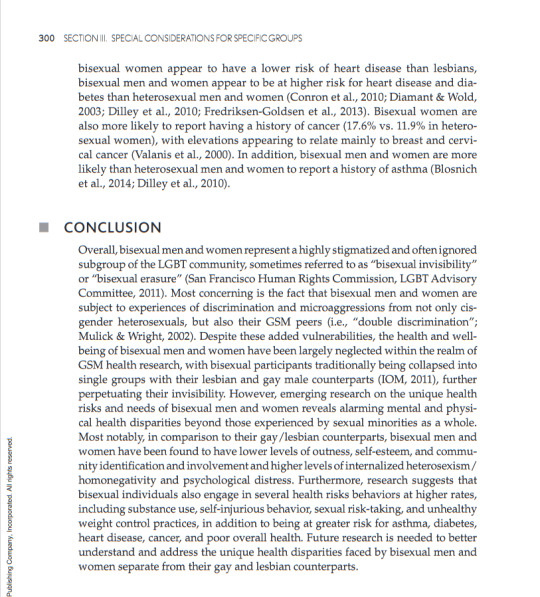
249 notes
·
View notes